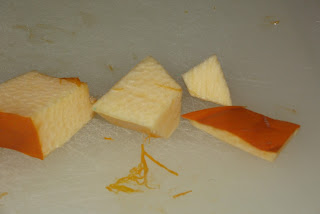 If you've been following along with the pumpkin-related posts to date, you should have a pumpkin already peeled, seeded and chopped. Be sure that the pumpkin is not chopped into too large of pieces. What's the point of canning pumpkin if you can only fit three chunks in each jar? The next step of your operation will be to gather your canning equipment, and review the basics of canning. The technique used for canning your pumpkin will be hot packing, and you will use a pressure canner to process your pumpkin.
If you've been following along with the pumpkin-related posts to date, you should have a pumpkin already peeled, seeded and chopped. Be sure that the pumpkin is not chopped into too large of pieces. What's the point of canning pumpkin if you can only fit three chunks in each jar? The next step of your operation will be to gather your canning equipment, and review the basics of canning. The technique used for canning your pumpkin will be hot packing, and you will use a pressure canner to process your pumpkin.
Place your peeled and chopped pumpkin into a large stockpot, cover with cold water and bring to a boil. Only allow it to boil for a minute or two, you just want to get it hot, not necessarily to cook it. It will get plenty of cooking in the pressure canner! Put your hot pumpkin chunks into your hot jars. In this case I decided that quarts would be good. You can add a teaspoon of salt to each quart jar if you desire.
 Next you will need to fill the jars with boiling water. An electric kettle works wonders in this situation!
Next you will need to fill the jars with boiling water. An electric kettle works wonders in this situation! Check your headspace using your headspace tool. You should have an inch of headspace for this canning application.
Check your headspace using your headspace tool. You should have an inch of headspace for this canning application. Turn your headspace tool over, or find another suitable thin plastic tool, and work out any air bubbles that may have formed during the filling process. Simply slide the tool down the outside of the food and work it around a bit. Shake, jiggle, pry, whatever you need to do to get those little bubbles out!
Turn your headspace tool over, or find another suitable thin plastic tool, and work out any air bubbles that may have formed during the filling process. Simply slide the tool down the outside of the food and work it around a bit. Shake, jiggle, pry, whatever you need to do to get those little bubbles out! Use a clean damp dishtowel or paper towel to wipe the rims of your jars.
Use a clean damp dishtowel or paper towel to wipe the rims of your jars. Use your lid lifter to place your lids onto your clean jar rims and screw on the rings. Remember that your rings should be "finger tight." They shouldn't be loose, but you don't have to crank them down with all your strength either.
Use your lid lifter to place your lids onto your clean jar rims and screw on the rings. Remember that your rings should be "finger tight." They shouldn't be loose, but you don't have to crank them down with all your strength either. Once the water has come to a boil in your pressure canner you can lower your jars into the vessel. Since the jars will likely be hot, you will want to use your canning tongs to lower them in safely.
Once the water has come to a boil in your pressure canner you can lower your jars into the vessel. Since the jars will likely be hot, you will want to use your canning tongs to lower them in safely. Once the vessel is pressurized and the weight is rocking nicely you can start your processing timer. I strongly urge you to refer to your pressure canner user's manual for processing weights and times. For me, I processed 1 hour 30 minutes at 15 pounds pressure.
Once the vessel is pressurized and the weight is rocking nicely you can start your processing timer. I strongly urge you to refer to your pressure canner user's manual for processing weights and times. For me, I processed 1 hour 30 minutes at 15 pounds pressure. Don't forget that when your processed jars come out of the canner, they should be placed on a dishtowel on the counter and not touched until they are completely cool. If you put a hot jar onto the cold counter, it may burst. If you move a warm jar, the seal may be broken. Just be patient, and wait for the little fellers to cool. It will be okay, I promise.
Don't forget that when your processed jars come out of the canner, they should be placed on a dishtowel on the counter and not touched until they are completely cool. If you put a hot jar onto the cold counter, it may burst. If you move a warm jar, the seal may be broken. Just be patient, and wait for the little fellers to cool. It will be okay, I promise.


















